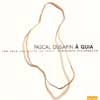Dusapin Concerto for Piano and Orchestra
An excellent introduction to one of today’s most thought-provoking composers
View record and artist detailsRecord and Artist Details
Composer or Director: Pascal Dusapin
Label: Montaigne
Magazine Review Date: 9/2004
Media Format: CD or Download
Media Runtime: 83
Mastering:
Stereo
Catalogue Number: MO782164

Tracks:
| Composition | Artist Credit |
|---|---|
| (7) Études pour piano |
Pascal Dusapin, Composer
Ian Pace, Piano Pascal Dusapin, Composer |
| Á quia - Concerto for Piano & Orchestra |
Pascal Dusapin, Composer
Christoph Eschenbach, Conductor Ian Pace, Piano Orchestre de Paris Pascal Dusapin, Composer |
Author: kYlzrO1BaC7A
Although Ligeti’s piano Etudes are established at the forefront of a genre previously vitalised by Chopin and Debussy, other contemporary composers have made an equally singular contribution. Maurice Ohana’s 12 (11/00) evince a Bartókian heritage, whereas Pascal Dusapin’s seven – written between 1997 and 2001 – bring a Debussian subtlety to bear on music whose improvisatory melodic contours and rhythmic inflections suggest the influence of traditional music and jazz respectively.
Etude No 1 has a preludial feel, with melodic arabesques unfolding across the piano in intricate waves, to which the rhythmic angularities and hammered pauses of No 2 are in marked contrast – as, in their turn, are the airy figuration of No 3, and the headlong though increasingly minimal gestures of No 4. Etude No 5 projects this repetition of pitches onto an expansive yet fragmented canvas, then the intensifying tremolos of No 6 bring the cycle to an explosive climax, leaving the distanced recollections of No 7 to act as a poignant epilogue. The Etudes make a diverse yet coherent whole in the hands of Ian Pace, who demonstrates a poise and variety of touch ideally suited to this music.
Whether or not Dusapin adds to his cycle of Etudes, the piano concerto À quia (2002) pursues many of the same procedures on a larger scale. Not that it conforms to Classical or Romantic archetypes any more than his earlier concertos (9/03): the title, which might be rendered as ‘nonplussedness’, infers a state where soloist and orchestra often perform ‘at’, but rarely ‘to’ and never ‘with’ each other. The first movement disperses its initial confrontation to arrive at a restive piano monologue, calmed by an expressive rising melody which is itself curtailed by a percussive outburst.
The second movement, beginning and ending in chamber-like concord, rises to a glowering orchestral tutti at its centre: a trajectory that the third movement polarises – moving from a meditative cadenza to the unstoppable infiltration of the orchestra, subsiding to leave the soloist once more alone and uncertain. Pace again takes the technical hurdles in his stride, and Christoph Eschenbach obtains a fervent response from the Orchestre de Paris, who continue to sound re-energised under his direction.
Each work is accommodated on a separate disc, and there are informative booklet-notes by Dusapin, Pace and the redoubtable Harry Halbreich, together with a DVD-Video track containing different accounts of the First and Fourth Etudes, and two films by Michel Follin which juxtapose rehearsals and interview sequences: just the sort of documentaries that should be being screened on BBC4. It all adds up to an excellent introduction to one of the most thought-provoking composers at work today.
Etude No 1 has a preludial feel, with melodic arabesques unfolding across the piano in intricate waves, to which the rhythmic angularities and hammered pauses of No 2 are in marked contrast – as, in their turn, are the airy figuration of No 3, and the headlong though increasingly minimal gestures of No 4. Etude No 5 projects this repetition of pitches onto an expansive yet fragmented canvas, then the intensifying tremolos of No 6 bring the cycle to an explosive climax, leaving the distanced recollections of No 7 to act as a poignant epilogue. The Etudes make a diverse yet coherent whole in the hands of Ian Pace, who demonstrates a poise and variety of touch ideally suited to this music.
Whether or not Dusapin adds to his cycle of Etudes, the piano concerto À quia (2002) pursues many of the same procedures on a larger scale. Not that it conforms to Classical or Romantic archetypes any more than his earlier concertos (9/03): the title, which might be rendered as ‘nonplussedness’, infers a state where soloist and orchestra often perform ‘at’, but rarely ‘to’ and never ‘with’ each other. The first movement disperses its initial confrontation to arrive at a restive piano monologue, calmed by an expressive rising melody which is itself curtailed by a percussive outburst.
The second movement, beginning and ending in chamber-like concord, rises to a glowering orchestral tutti at its centre: a trajectory that the third movement polarises – moving from a meditative cadenza to the unstoppable infiltration of the orchestra, subsiding to leave the soloist once more alone and uncertain. Pace again takes the technical hurdles in his stride, and Christoph Eschenbach obtains a fervent response from the Orchestre de Paris, who continue to sound re-energised under his direction.
Each work is accommodated on a separate disc, and there are informative booklet-notes by Dusapin, Pace and the redoubtable Harry Halbreich, together with a DVD-Video track containing different accounts of the First and Fourth Etudes, and two films by Michel Follin which juxtapose rehearsals and interview sequences: just the sort of documentaries that should be being screened on BBC4. It all adds up to an excellent introduction to one of the most thought-provoking composers at work today.
Discover the world's largest classical music catalogue with Presto Music.

Gramophone Digital Club
- Digital Edition
- Digital Archive
- Reviews Database
- Full website access
From £8.75 / month
Subscribe
Gramophone Full Club
- Print Edition
- Digital Edition
- Digital Archive
- Reviews Database
- Full website access
From £11.00 / month
Subscribe
If you are a library, university or other organisation that would be interested in an institutional subscription to Gramophone please click here for further information.




